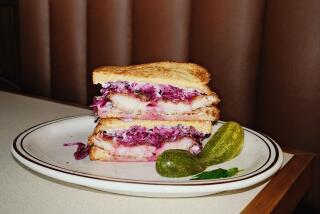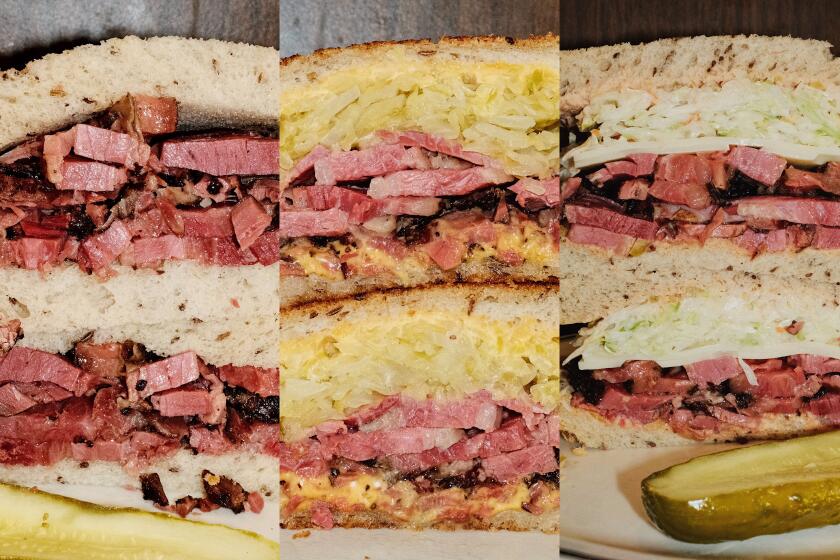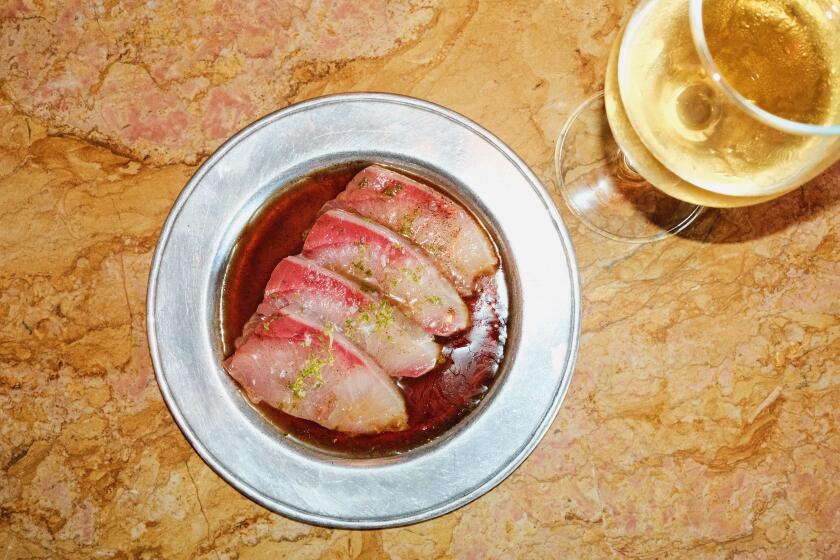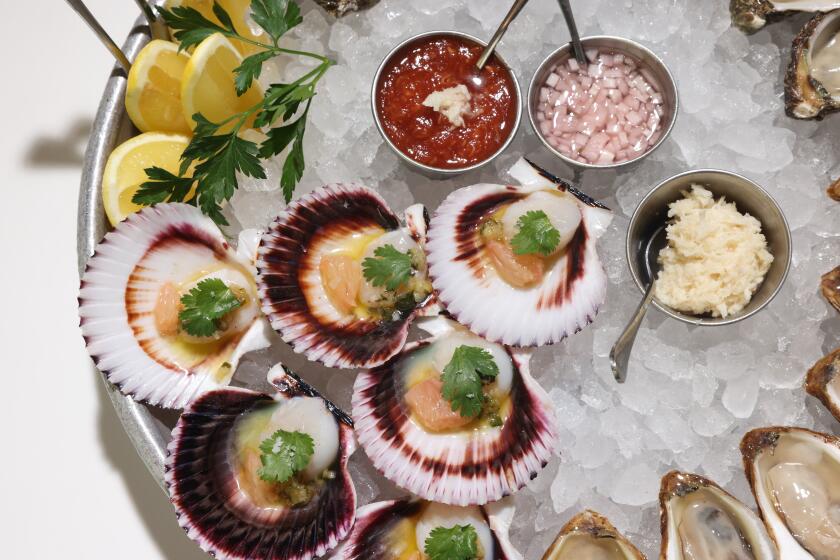The future of Gravenstein apples hangs on a thin stem
With thick, hollow trunks and lichen-draped limbs propped up on crutches, the century-old Gravenstein trees at Walker Apples look less like a working orchard than an arboreal infirmary, or the rear guard of a retreating army. The 20 square miles of Gravensteins that once covered the local hills are now reduced to one, and the remaining trees also would have succumbed to chain saws were it not for the matchless flavor of their fruits and the determination of a small band of farmers and preservationists.
The fruit market is a pitiless executioner of noncompetitive varieties, but a quixotic Slow Foods group has inspired a modest revival in demand for fresh Gravensteins, which are even starting to show up at markets in Los Angeles after an absence of a quarter-century.
Since its origin in 17th century Denmark, Gravenstein has been prized for its crisp but tender flesh, sweet-tart juice and intense, distinctive aroma, honeyed, floral and fruity. The great English pomologist Edward Bunyard wrote in 1929: “Of Gravenstein it is hard to speak in mere prose, so distinct in flavour is it, Cox itself not standing more solitary, so full of juice and scented with the very attar of apple. This aroma comes out on the oily skin and remains on the fingers despite many washings, bringing to mind the autumnal orchard in mellow sunlight.”
Gravenstein is still a favorite in northern Europe and is cultivated from Nova Scotia to the Pacific Northwest, but it reaches its greatest perfection in the Sebastopol district of western Sonoma County, at the border of the maritime and inland climatic zones, where the morning fog gives way to a moderately hot afternoon sun. The area’s fine, sandy loam soil is well suited to apples. The huge trees, grafted on seedling rootstock, develop roots deep enough to survive the dry summers without irrigation.
A century ago, before controlled atmosphere storage and imports from the Southern Hemisphere made apples available year-round, Sebastopol Gravensteins brought high prices as the earliest top-quality variety on the market, ripening from the end of July to the beginning of September. The pick of the crop was packed fresh and shipped throughout California and to Eastern markets, while the majority of the fruit was processed into dried apples, juice, sauce, pie filling and vinegar. Sebastopol prospered and named its roads, schools and festivals after its iconic apple.
Today only one commercial shipper of fresh Gravensteins remains in Sebastopol, 80-year-old Lee Walker. As he related on a recent visit to his orchard, his ancestor Joseph Walker discovered Yosemite Valley in 1833, a little more than a decade after Russian settlers introduced the Gravenstein to Fort Ross, on the Sonoma coast. Joseph’s brother settled in Sebastopol about 1850 and raised cattle and apples on 7,000 acres. A neighbor named Griffeth established the first real Gravenstein orchard in the 1880s, and in 1910, Lee Walker’s maternal grandfather planted the Gravensteins on the home ranch where we strolled.
Lee and his son now farm 50 acres of apples, about half of them Gravensteins, which are easy to spot because the trees are huge. Partly because it’s a triploid, with three sets of chromosomes instead of the usual two, Gravenstein trees on seedling rootstock grow 20 feet high or more, too tall for convenient access — one of several quirks that caused the variety’s decline, despite its excellent flavor and versatility.
Americans buy fruit with their eyes, and most Gravensteins of the standard strain remain a dull light green when ripe, although some fruits exposed to the sun develop a straw-yellow ground color gorgeously streaked with red and orange. Walker’s favorite is the Rosebrook strain, named after a local family, which produces a higher percentage of such attractively striped fruits, with similar quality. There is also a Red Gravenstein that produces solid red fruits, but these are softer and less richly flavored.
Gravenstein’s intense aroma partly derives from its high response to ethylene, a natural plant hormone linked to ripening, which on the downside causes the variety to have a very short shelf life. It bruises easily, and within a week or two after harvest the skin becomes waxy and greasy, and the flesh turns soft and mealy.
The disturbing sound of Gravensteins falling from the trees and plopping on the ground accompanied our progress through the orchard. “Gravs have a short, weak stem, and when the wind shakes them, down they go,” said Walker ruefully. “Forty percent of my crop falls on the ground.”
As he spoke, workers gathered unripe apples off the ground into bins, to be sold for making vinegar, at the salvage price of $45 a ton, to Sebastopol’s last remaining processor, Manzana Apple Products.
Landowners have a much more profitable option, planting wine grapes, which last year brought $2,000 a ton, almost 10 times the price for processed ripe Gravs. Gravenstein acreage has contracted steadily, from 1,200 a decade ago to 763 in 2010, while Sonoma wine grapes increased to 56,300. Even Walker put in a small plot of grapes.
“I hate to admit it, but a lot of years we make more money off those 2 acres of grapes than we do off all the apples,” he said.
When I had visited Walker previously, in 2002, he had seemed resigned to the eventual demise of the Gravenstein apple industry so deeply intertwined with his family’s and community’s history.
“We were losing money; we were getting killed,” he said.
But in 2003, the Russian River chapter of Slow Food, an organization dedicated to the preservation of local food traditions, launched a project called a presidium (Latin for “fortress”) to rescue Sebastopol Gravenstein cultivation. Led by Paula Shatkin, a former Angeleno who fell in love with the Gravenstein, about two dozen volunteers have worked to tell consumers about the variety’s superb flavor, its history and sources that sell it. They have organized events at farmers markets, recruited restaurants to feature Gravensteins on their menus and sponsored, with a distributor called the FruitGuys, a mail-order service that buys Gravensteins from Walker and other top growers.
“People feel passionate about this apple, but we have had to work hard to educate them about the real risk of losing it,” Shatkin said.
As the project gained traction, Walker decided to try growing Gravensteins one more year, raising the best apples he could by hand-thinning, a costly practice largely forsaken in a processing-based industry. This produced larger, more marketable, more flavorful fruit. Since Slow Food adopted the Gravenstein, demand for his fresh fruit has doubled, and he has been able to raise prices to $28 from $18 for a 40-pound box, he said.
However, more than 90% of the Sonoma Gravenstein harvest goes to processing, where prices are depressed by cheap imports of Chinese apple juice concentrate.
“The bottom line is, prices are not at a sustainable level for our industry,” said David Hale, a meticulous grower whose family has farmed apples locally since 1886.
Most problematically, say growers, as sanitary standards have tightened in recent years, processors have stopped accepting, or pay very little for, “grounders,” even though the products made from them are pasteurized and perfectly safe.
“If it gets to the point that they don’t use them anymore, we’ll be in deep trouble,” said Perry Kozlowski, a longtime Gravenstein grower who has hedged his bets with wine grapes and a farm stand selling gourmet foods.
In recent years, many Gravenstein growers have switched from conventional to organic growing practices, and this is one sector of the industry that seems to be flourishing. For example, Paul and Kendra Kolling of Nana Mae’s Organics farm 400 acres of apples in Sebastopol, 75 of them Gravensteins, on plots leased from about 100 landowners, many of them old orchards that would otherwise be abandoned. Crucially, they have their own brand of premium juice and apple sauce, and benefit from the added value.
“We decided early on that organic was our niche,” Kendra said. “Now we can’t grow enough to supply our customers.”
With the right approach, and clever marketing, there may be life in the old apple yet.
More to Read
Eat your way across L.A.
Get our weekly Tasting Notes newsletter for reviews, news and more.
You may occasionally receive promotional content from the Los Angeles Times.









